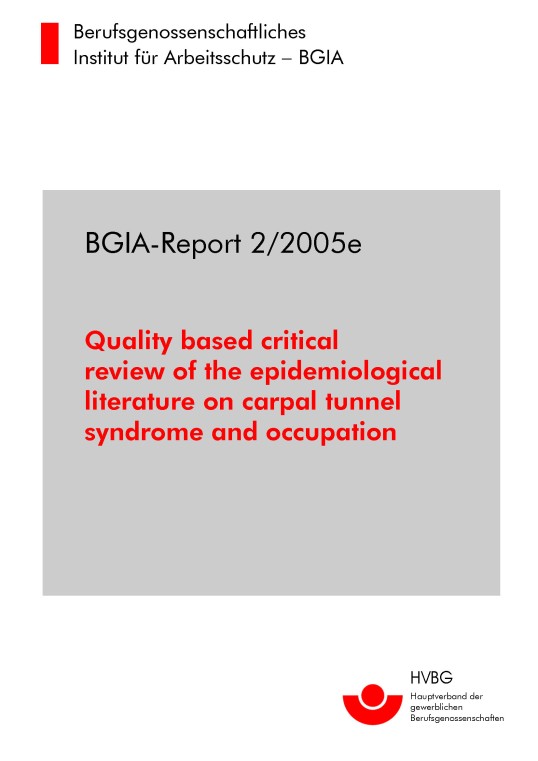- Database publications
- Reports - Download
- Latest publications
- Focus on IFA's and IAG's work
- IFA-Handbuch
- IFA-Arbeitsmappe Messung von Gefahrstoffen
- Gefahrstoffe - Reinhaltung der Luft
Quality based critical review of the epidemiological literature on carpal tunnel syndrome and occupation (BGIA-Report 2/2005e)
Abstract: Carpal tunnel syndrome (CTS) is a disorder of the hand wrist caused by mechanical entrapment or inflammation of the median nerve. Accepted risk factors include age, gender, hormonal changes, and metabolic diseases. The association between CTS and physical activities, including work exposures, is less clear. 334 articles published between 1997 and 2003 were reviewed. This report summarizes results from 34 occupational epidemiological studies that met specific quality criteria. A small number of studies defined repetitive work and CTS in a consistent enough manner to conclude that the evidence supports a modest positive association between repetitive work activities and risk of CTS. Three studies reported an effect of forceful work activities on CTS risk. However, since exposure and outcome definitions were not comparable, no firm conclusions regarding this relationship may be drawn. There is insufficient epidemiological evidence to either support or refute an association between other work activities and CTS. Overall, the quality of research regarding the association between occupation and CTS has improved since 1997. However, the lack of a "gold standard" medical diagnostic technique represents a major hurdle yet to be overcome. Any future investigation or literature review must address the fact that the prevalence, incidence and risk factors for CTS depend strongly on the case definition used.
Bibliographic data

Sulsky, S.I.; Mastroberti, M.A.; Schmidt, M.D.: Quality based critical review of the epidemiological literature on carpal tunnel syndrome and occupation.
BGIA-Report 2/2005e.
Hrsg.: Hauptverband der gewerblichen Berufsgenossenschaften (HVBG), Berufsgenossenschaftliches Institut für Arbeitsschutz - BGIA, Sankt Augustin 2005.
ISBN: 3-88383-690-7

